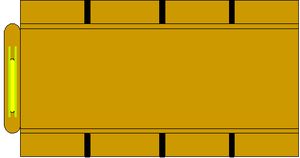For years, box manufacturers have been searching for a means of cost-effectively embedding RFID tags into packaging. Doing so could provide a significant competitive advantage in that industry by providing a streamlined means for consumer packaged goods (CPG) manufacturers to meet the RFID-tagging requirements issued by their customers—namely, retailers such as Wal-Mart and Target.
Hide-Pack, a packaging solutions startup based in Montreal, claims it has discovered a method of integrating RFID inlays into boxes that doesn’t slow box production and can reduce the costs for CPG manufacturers to RFID-enable the cases of goods they sell. Furthermore, the company says its process operates in a manner that was previously thought to be a bad idea: by placing the inlay inside a box joint.
The joint of a box—the seam, where two sides of the box overlap and join together—is crucial to a box’s physical integrity (its strength). Box-making 101 teaches that nothing but adhesive or staples should be inside this seam because foreign objects could hamper the box’s compression ratio, or the number of boxes (of the same size and strength) that can safely be stacked. But taking this counter-intuitive approach, Hide-Pack found that placing an RFID inlay within the joint not only fails to degrade box strength, it also provides a means of protecting the inlay from dirt, moisture and abuse. Moreover, it also provides the inlay with a buffer (formed by the two layers of corrugate between which the inlay is sandwiched) that improves its readability when the box is filled with RF-interfering materials, such as water or metal.
To bring this patent-pending approach to market, Hide-Pack has partnered with Domino Integrated Solutions Group (Domino IGS), a provider of auto-ID technologies and data-integration services for the packaging industry. Domino says it will provide the Hide-Pack solution—which includes the company’s inlay-insertion technology, an RFID inlay reader and applicator, on-site education, feasibility studies, and pilot and project design, as well as full integration and implementation services—to box manufacturers, for approximately $150,000 per packaging line.
Paul de Blois, Hide-Pack’s VP and general manager, says CPG manufacturers under tagging requirements stand to realize significant cost savings by purchasing RFID-enabled packaging from box makers rather than adding RFID-enabled labels themselves prior to shipping goods to retailers. The bare RFID inlay that the Hide-Pack system would embed into a box is 35 percent cheaper, de Blois explains, than an RFID label a CPG manufacturer might currently place on the outside of a box.
In addition, de Blois adds, CPG companies could lower their infrastructure costs by using Hide-Pack cases since they would not need to purchase RFID printer-encoders and label applicators. Other benefits companies could realize by using RFID-enabled boxes, de Blois says, include the ability to begin tracking and tracing products earlier in the supply chain, and integrating RFID data into a company’s transportation and warehouse management systems.
But do box manufacturers currently see enough demand for RFID-enabled boxes to justify the costs of integrating RFID tags into their products? While the additional costs of deploying Hide-Pack’s RFID system on a packaging line could be amortized to less than a penny per box when used to RFID-enable 20 million boxes, CPG firms are not presently creating a demand for more than 2 or 3 million RFID-enabled boxes per year, says Dwain Farley, CEO for the Americas division at Domino IGS. Still, he notes, this demand should grow consistently as Wal-Mart and other retailers begin asking suppliers to ship an increasing number of products in RFID-tagged cases each year. What’s more, Farley states, box makers wouldn’t need to dedicate a line to producing only RFID-enabled boxes, since the Hide-Pack system can be turned on and off quickly.
A number of box-makers are already engaged with Domino on pilot projects, Farley says, though non-discloser agreements preclude him from sharing company names. There is particularly strong interest, he adds, from makers of the wax-covered corrugate used for shipping produce, because the readability of RFID-enabled labels slapped to the outside of boxes carrying water-rich produce has been a major hurdle for produce companies. The placement of the inlay embedded in the box joint, he says, improves the tag’s readability.
According to Farley, being encased within the box joint adhesive fortifies the RFID inlays from water damage. The company performed tests in which its boxes were soaked in water or placed inside freezers, neither of which prevented the tags from being consistently readable as they were moved down conveyor systems at speeds of up to 600 feet per minute—the target speed for tag readability at Wal-Mart distribution centers.
Hide-Pack has tested its approach with a variety of package-making equipment, used to manufacture everything from large corrugate boxes to smaller product-level packages (such as thinner cartons used for facial tissue, cereal boxes or other products) and envelopes (think FedEx). The company claims the system works with all of these types of packaging.
While testing the system with a corrugate box-making line using a Flexo Folder Gluer (the dominant system used in manufacturing corrugate cases), Hide-Pack has been able to insert an inlay into each box moving through the gluer at speeds of up to 18,000 units per hour. This, according to François Bozet, vice president of technology for Hide-Pack, is the maximum line speed of most Flexo Folder Gluer machinery.
Because its system tests each inlay to ensure its functionality before applying it to the box, Hide-Pack says the tags in finished boxes have a failure rate of 0.1 percent or less. It has also tested its method with various types of adhesives, as well as with passive UHF EPC Gen 2 inlays from eight tag makers. In addition, the company has performed tests at a recycling mill, which reportedly showed that the RFID inlay, despite being embedded into the box seam, could be extracted from the corrugate using standard contaminant-extraction filters already in use at corrugate recycling mills. (These same filters currently remove RFID labels from the outside of corrugate boxes.)


